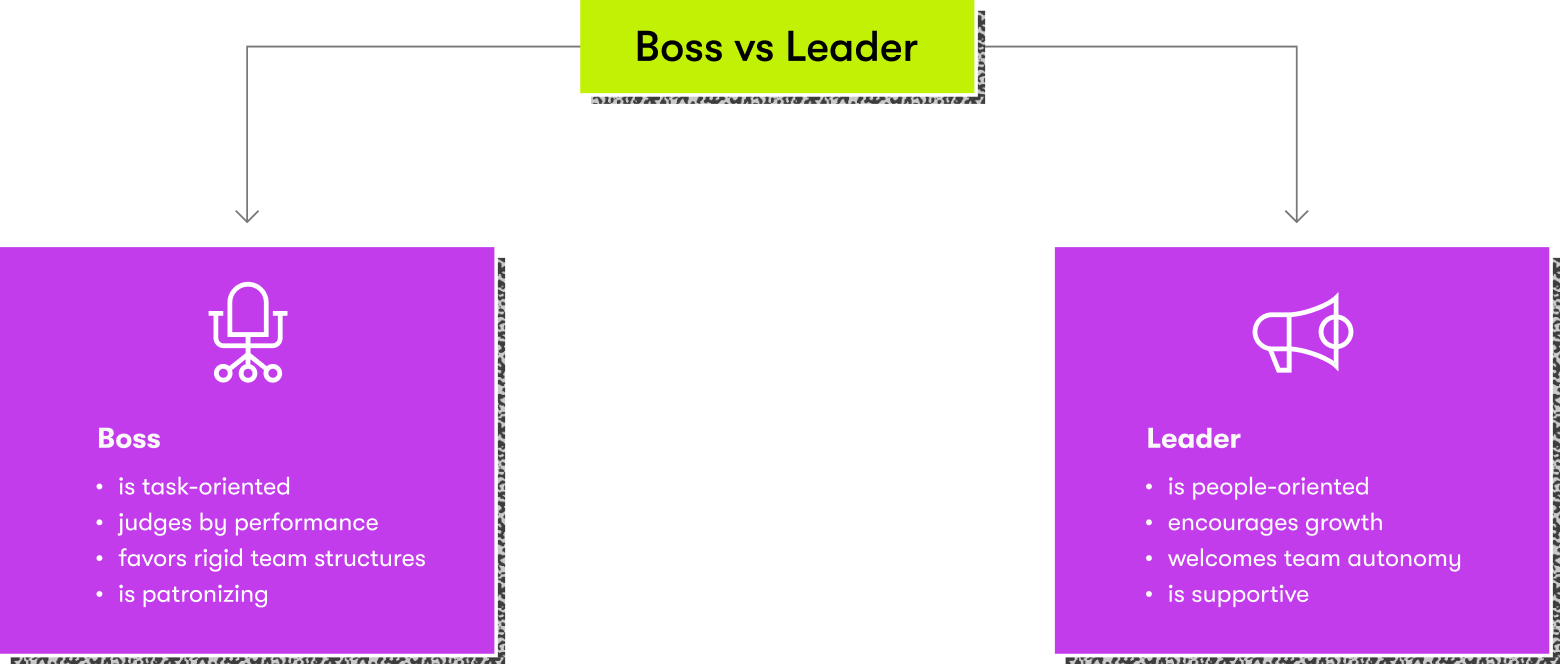Working in remote tech, teams generally have either a boss or a leader. Sometimes, there can actually be both. If you’ve recently been promoted to a leading role at your company, it’s high time you understand the key differences between the two.
Most employees would rather work with a leader than with a boss. This is likely due to the typical boss stereotype: mean, loud, and overbearing. On the other hand, leaders are often viewed as guides, builders, and teachers. This thumbnail sketch of the two is somewhat accurate, but it is a bit unfair to bosses.
There are at least 12 known leadership styles, and each one has its pros and cons. My biggest challenge as a leader was to figure out what kind of leadership style worked for me, and how to stretch and mix that with other styles of leadership that are most appropriate for a given moment. I learned self-awareness and how to quickly adapt my style to respond and act.

At some point, almost everyone had to deal with a difficult boss in their career. It’s important to realize that most of the related issues stem from the very role of a boss, rather than who they are as a person.
Leaders aren't always under the same pressures as bosses. Even if they are, leaders tend to rise above the stress to lead their team on to success. This is the main difference between the two, but let’s break it down a bit more.
Boss vs leader: mentality
The first difference you’ll notice in a leader vs a boss is their overall mentality.
Bosses and leaders often have similar goals but they may have very different approaches to reaching that goal. Individual personality can also greatly affect whether someone presents as a boss or a leader.
Leader mentality
A leader's mentality can be summed up in one word: people.
Instead of being above the group, a leader is one of the team members. Leaders understand that success means building a connection with each person on their team. They also go the extra mile to build a personal connection with companies that their team works with.
This kind of effective engagement can be more difficult with a remote tech team, but a leader can overcome that challenge.
A true leader strives to develop their team's skills, so that it can reach its full potential. They lead by example, and build trust relationships for the success of the team and the organization.

Boss mentality
A boss focuses more on improving productivity than on improving their team. Generally, their approach can be summed up as: “Do it my way, and do it now.”
Often, this mentality is not driven by ego. They just know that the job needs to be done as quickly as possible. A boss may also be concerned that if they aren't forceful enough with the people on their team, the job won't get done.
This is why a boss can come across as critical as well as demanding.
Boss vs leader: organization
Another difference between leaders and bosses is related to how they organize their teams.
Bosses and leaders both realize that good organization is critical to a successful software engineering team. To keep everyone on track, they'll often have a strong system in place.
The key difference lies in how they implement their organizational system.
Leader organization
Leaders are generally more people-oriented. An early organizational step they take is to train their team.
A leader understands that the project will be completed more quickly and effectively if everyone is comfortable with their responsibilities.
Because they've developed a personal relationship with each member of their team, a leader is usually less controlling. They trust that their team will get the job done, and that their team will come to them with any questions or problems.
A leader also helps remote team members remain connected to each other and to the goal.
A leader needs to put themself in their team’s shoes, to empathize with each of the software engineers. Many think leaders deal with more high-level strategies, which fails to recognize the importance of each building block that goes into it. If the leader sets the task properly, removes roadblocks, and makes the team’s work comfortable, the team will respond by reaching the established goals as expected and on time. This is the key to meeting the overall mission in the first place.

Boss organization
A boss organizes their team in a way that is guaranteed to provide results.
They aren't interested in helping their team members grow unless it's necessary for completing a project. If someone is good at a certain task, then that's where a boss wants them to stay.
A boss's organization motto is: “If it isn't broken, don't fix it.”
A boss is determined to make sure that their team achieves success as quickly as possible. Often, this is because a boss wants recognition from their superiors. It may also mean that they genuinely care about the project that the team is working on.
A boss focuses on pre-existing systems that they can implement when organizing their team. They figure that it's safer to use a proven method instead of taking the time to come up with their own.
Leader vs boss: followers
The final difference between leaders and bosses is their followers. An employee or team member will interact differently with a boss than they would with a leader.
Leaders’ followers
Leaders encourage their followers to be innovative and find the best solution to a problem. This creates a team environment where members are willing to take risks to create innovative software and solutions.
Employees and team members will also be comfortable enough to reach out to a leader for help. They trust the leader to provide a calm, reasonable solution because they've developed a personal relationship with them.
Bosses’ followers
Boss followers generally operate in a realm of fear. Sometimes, it's the fear of being fired. Other times, it's the fear of being lectured in front of the rest of the team.
It is not uncommon for team members to expect a boss to either micromanage or not provide enough assistance. This occurs because bosses trust their systems, so they tend to believe that any problems must be the result of team member flaws.
Team members believe their boss looks down on them. This creates a stressful work environment. Stress, fear, and a lack of communication will cause the final product to suffer.
The software or project will be adequate, but not outstanding. An additional complication is that if a boss has an outsize ego, they might even remove from the team someone who outshines them, which will further damage productivity.
Boss vs leader in one image
All of this information is layered into the stereotypical boss vs leader meme:

Leading by example, a true leader collaborates and helps their team get to the top faster and more efficiently. A boss, however, often focuses on stringent organizational processes that don’t allow room for innovation or individuality.
Can a boss be a leader?
One final point we should emphasize is that a boss is capable of becoming a leader.
A boss can make the transition to being a leader by shifting their focus to their team members. They must work toward understanding each team member's strengths and weaknesses.
There are many characteristics of a true leader, but I would list five of them: integrity, accountability, ability to delegate, empathy, and self-awareness.

Developing a relationship with their employees or team members will stimulate growth as well as creativity. A boss-leader can also be very successful at preventing employee burnout.
Bosses have the benefit of support from their company that a leader might not have. They also have a strong personal commitment to structure and getting things done correctly the first time. When the attributes of a boss and leader are combined, it is beneficial for both the team and the company as a whole

As Chief Editor, Darya works with our top technical and career experts at EPAM Anywhere to share their insights with our global audience. With 12+ years in digital communications, she’s happy to help job seekers make the best of remote work opportunities and build a fulfilling career in tech.
As Chief Editor, Darya works with our top technical and career experts at EPAM Anywhere to share their insights with our global audience. With 12+ years in digital communications, she’s happy to help job seekers make the best of remote work opportunities and build a fulfilling career in tech.
Explore our Editorial Policy to learn more about our standards for content creation.
read more


























